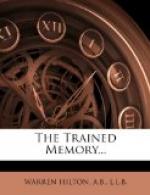A SCIENTIFIC MEMORY SYSTEM FOR BUSINESS SUCCESS
[Illustration: Decorative Header]
CHAPTER VII
A SCIENTIFIC MEMORY SYSTEM FOR BUSINESS SUCCESS
[Sidenote: Importance of Associates]
We recall things by their associates. When you set your mind to remember any particular fact, your conscious effort should be not vaguely to will that it shall be impressed and retained, but analytically and deliberately to connect it with one or more other facts already in your mind.
[Sidenote: "Cramming” and “Willing"]
The student who “crams” for an examination makes no permanent addition to his knowledge. There can be no recall without association, and “cramming” allows no time to form associations.
If you find it difficult to remember a fact or a name, do not waste your energies in “willing” it to return. Try to recall some other fact or name associated with the first in time or place or otherwise, and lo! when you least expect it, it will pop into your thoughts.
If your memory is good in most respects, but poor in a particular line, it is because you do not interest yourself in that line, and therefore have no material for association. Blind Tom’s memory was a blank on most subjects, but he was a walking encyclopedia on music.
[Sidenote: Basic Principle of Thought-Reproduction]
To improve your memory you must increase the number and variety of your mental associations.
Many ingenious methods, scientifically correct, have been devised to aid in the remembering of particular facts. These methods are based wholly on the principle that that is most easily recalled which is associated in our minds with the most complex and elaborate groupings of related ideas.
[Sidenote: Methods of Pick]
Thus, Pick, in “Memory and Its Doctors,” among other devices, presents a well-known “figure-alphabet” as of aid in remembering numbers. Each figure of the Arabic notation is represented by one or more letters, and the number to be recalled is translated into such letters as can best be arranged into a catch word or phrase. To quote: “The most common figure-alphabet is this:
1 2 3 4 5 6 7 8 9 0
t n m r l sh g f b s
d j k v p o
ch
c
g
qu z
“To briefly show its use, suppose it is desired to fix 1,142 feet in a second as the velocity of sound, t, t, r, n, are the letters and order required. Fill up with vowels forming a phrase like ‘tight run’ and connect it by some such flight of the imagination as that if a man tried to keep up with the velocity of sound, he would have a ‘tight run.’”
[Sidenote: Scientific Pedagogy]




